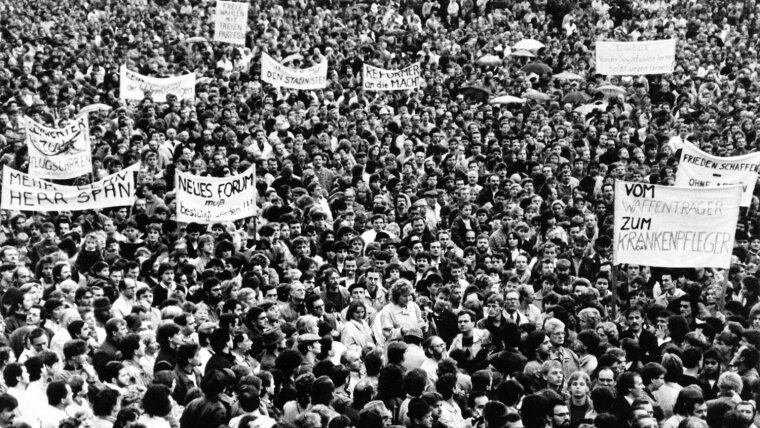
The Berlin Wall fell on 9 November 1989, 30 years ago. Those who were there will certainly remember the moment, which symbolizes the success of the peaceful revolution in the GDR like no other. But how was the situation at the Friedrich Schiller University Jena in autumn 1989?
We take a look back at history.
»As far as I’m aware… immediately«. Those were the clumsy words, stuttered by SED official Günter Schabowski, which brought the Berlin Wall to the ground. As the euphoria of 9 November 1989 set in, the steam began to escape from the pressure cooker known as the GDR. Yet the »revolution«—the term used by SED Secretary General, Egon Krenz—had already reached its climax by 4 November. Hundreds of thousands of people gathered on Alexanderplatz in Berlin to celebrate the speakers of the opposition and jeer the hardliners of the nomenklatura. It had been brewing in the country for quite some time—and not just in political centres like Berlin and Leipzig; resistance had also been stirring in the provinces. The courage of individuals suddenly blossomed into a mass movement. While Mikhail Gorbachev was demanding glasnost and perestroika—openness and reformation—in the Soviet Union, the GDR remained at a standstill. The USSR had become a bearer of hope, which made it all the more astonishing when »Sputnik«, the Soviet press digest, was banned in November. One year previously, SED Chief Ideologist Kurt Hager had stated that you do not have to redecorate your house just because your neighbour is renovating his own.
»Reformhaus« as the precursor of thestudent council
Things remained quiet at the University of Jena for a long time. Critical thinkers like Roland Jahn, Jürgen Fuchs, Lutz Rathenow, and Siegfried Reiprich had already been expelled in previous years. The first sign of rebellion was the Ambulancia campaign of 1988, when students raised money for an ambulance for Nicaragua without the involvement of the »Free German Youth«, the official youth organization of the GDR. This continued in autumn 1989, when the »Reformhaus«, a plenum within the university, was held by around 800 students, some employees and guests. A special edi-tion of the socialist university newspaper was even published on the theme of »courage not rage«. The »Reformhaus« led to the emergence of the student council in mid-November 1989. Rector Hans Schmigalla recognized the committee—»despite concerns«—and was open to cooperation, which led to the establishment of the student council on 23 November 1989. Gert Noack became the first chairman.
In early December, when the Berlin Wall was already history, the »Action Committee for the Democratic Rehabilitation of the University« was founded on the initiative of several lecturers led by the late Dietfried Jorke. This was followed by the reelection of the Academic Council in January 1990 and
the election of a new rector in February: While Gerhard Riege received the most votes, the jurist’s election was disputed. In April 1990, physicist Ernst Schmutzer prevailed as the 314th rector of the Alma Mater Jenensis. Under his aegis, the university made the laboured transition to a restored, democraticized institution.
By Stephan Laudien